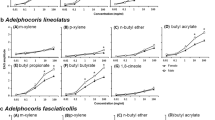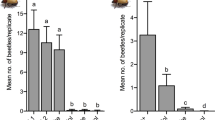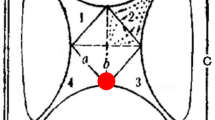Abstract
Western skunk cabbage, Lysichiton americanus (Araceae), is pollinated mainly by the rove beetle Pelecomalium testaceum (Staphylinidae). Our objective was to determine the floral semiochemical(s) of L. americanus that attract(s) P. testaceum. Porapak Q headspace volatile extracts of L. americanus inflorescences were analyzed by gas chromatographic–electroantennographic detection (GC–EAD) and GC–mass spectrometry. In GC–EAD analyses, three floral odorants [(E)-4 nonene, (E)-5-undecene, indole] elicited consistent responses from the antennae of female P. testaceum. In field experiments, traps baited with a blend of these three components (“3-CB”) captured significantly more P. testaceum than unbaited control traps. Traps baited with the 3-CB, the two hydrocarbons, or indole, each captured significantly more beetles than unbaited control traps, indicating redundancy in the semiochemical blend. Moreover, traps baited with indole captured significantly more beetles than traps baited with either the 3-CB, or the hydrocarbons, indicating that indole is a key floral attractant for P. testaceum. Many necrophilous and coprophilous insects respond to indole in search of carrion or feces, but P. testaceum has never been associated with these types of resources. Both electrophysiological and behavioral responses of P. testaceum to two hydrocarbon semiochemicals, which are not signature odorants of carrion or feces, may indicate that the beetles recognize the odor of L. americanus as an honest signal, seek and pollinate its inflorescences, and get rewarded with pollen and on-plant mating opportunities.




Similar content being viewed by others
References
Archer MS, Elgar MA (2003) Female breeding-site preferences and larval feeding strategies of carrion-breeding Calliphoridae and Sarcophagidae (Diptera): a quantitative analysis. Aust J Zool 51:165–174
Arn H, Städler E, Rauscher S (1975) The electroantennographic detector—a selective and sensitive tool in the gas chromatographic analysis of insect pheromones. Z Naturforsch 30:722–725
Beath DDN (1996) Pollination of Amorphophallus johnsonii (Araceae) by carrion beetles (Phaeochrous amplus) in a Ghanaian rain forest. J Trop Ecol 12:409. https://doi.org/10.1017/S0266467400009603
Bischoff M, Raguso RA, Jürgens A, Campbell DR (2015) Context-dependent reproductive isolation mediated by floral scent and color. Evolution 69:1–13. https://doi.org/10.1111/evo.12558
Blanckenhorn W (2015) Quantitative genetics of life history traits in coprophagous and necrophagous insects. In: Benbow ME, Tomberlin J, Tarone A (eds) Carrion ecology, evolution, and their applications. CRC Press, Boca Raton, pp 333–352
Borg-Karlson A-C, Englund FO, Unelius CR (1994) Dimethyl oligosulphides, major volatiles released from Sauromatum guttatum and Phallus impudicus. Phytochemistry 35:321–323
Brodie BS, Wong WHL, Vanlaerhoven S, Gries G (2014) Is aggregated oviposition by the blow flies Lucilia sericata and Phormia regina (Diptera: Calliphoridae) really pheromone-mediated? Insect Sci 22:651–660. https://doi.org/10.1111/1744-7917.12160
Brodie BS, Babcock T, Gries R, Benn A, Gries G (2016) Acquired smell? Mature females of the common green bottle fly shift semiochemical preferences from feces feeding sites to carrion oviposition sites. J Chem Ecol 42:40–50. https://doi.org/10.1007/s10886-015-0658-7
Burger BV, Petersen WG, Ewig B, Neuhaus J, Tribe GD, Spies HSC, Burger WJG (2008) Semiochemicals of the Scarabaeinae VIII. Identification of active constituents of the abdominal sex-attracting secretion of the male dung beetle, Kheper bonellii, using gas chromatography with flame ionization and electroantennographic detection in par. J Chromatogr A 1186:245–253. https://doi.org/10.1016/j.chroma.2007.09.041
Carter DO, Yellowlees D, Tibbett M (2007) Cadaver decomposition in terrestrial ecosystems. Naturwissenschaften 94:12–24. https://doi.org/10.1007/s00114-006-0159-1
Chartier M, Gibernau M, Renner SS (2014) The evolution of pollinator-plant interaction types in the Araceae. Evolution 68:1533–1543. https://doi.org/10.1111/evo.12318
Chaudhury MF, Zhu JJ, Skoda SR (2015) Response of Lucilia sericata (Diptera: Calliphoridae) to screwworm oviposition attractant. J Med Entomol 52:527–531. https://doi.org/10.1093/jme/tjv054
Chen J, Meeuse BJD (1971) Production of free indole by some aroids. Acta Bot Neerlandica 20:627–635. https://doi.org/10.1111/j.1438-8677.1971.tb00206.x
Cortez V, Verdu JR, Ortiz AJ, Halffter G (2017) Identification and evaluation of semiochemicals for the biological control of the beetle Omorgus suberosus (F.) (Coleoptera: Trogidae), a facultative predator of eggs of the sea turtle Lepidochelys olivacea (Eschscholtz). PLoS One 12:119. https://doi.org/10.1371/journal.pone.0172015
Cossé AA, Baker TC (1996) House flies and pig manure volatiles: wind tunnel behavioral studies and electrophysiological evaluations. J Agric Entomol 13:301–317
Dekeirsschieter J, Verheggen FJ, Gohy M, Hubrecht F, Bourguignon L, Lognay G, Haubruge E (2009) Cadaveric volatile organic compounds released by decaying pig carcasses (Sus domesticus L.) in different biotopes. Forensic Sci Int 189:46–53. https://doi.org/10.1016/j.forsciint.2009.03.034
Dekeirsschieter J, Frederick C, Verheggen FJ, Drugmand D, Haubruge E (2013) Diversity of forensic rove beetles (Coleoptera, Staphylinidae) associated with decaying pig carcass in a forest biotope. J Forensic Sci 58:1032–1040. https://doi.org/10.1111/1556-4029.12095
Diaz A, Kite GC (2006) Why be a rewarding trap? The evolution of floral rewards in Arum (Araceae), a genus characterized by saprophilous pollination systems. Biol J Linn Soc 88:257–268. https://doi.org/10.1111/j.1095-8312.2006.00612.x
Dötterl S, David A, Boland W, Silberbauer-Gottsberger I, Gottsberger G (2012) Evidence for behavioral attractiveness of methoxylated aromatics in a dynastid scarab beetle-pollinated Araceae. J Chem Ecol 38:1539–1543. https://doi.org/10.1007/s10886-012-0210-y
Dunkelblum E, Tan SH, Silk PJ (1985) Double-bond location in monounsaturated fatty acids by dimethyldisulfide derivatization and mass spectrometry: application to analysis of fatty acids in pheromone glands of four Lepidoptera. J Chem Ecol 11:265–277
Eby C, Gardiner MGT, Gries R, Judd GJR, Khaskin G, Gries G (2013) Phenylacetaldehyde attracts male and female apple clearwing moths, Synanthedon myopaeformis, to inflorescences of showy milkweed, Asclepias speciosa. Entomol Exp Appl 147:82–92. https://doi.org/10.1111/eea.12045
El-Sayed AM, Byers JA, Manning LM, Jurgens A, Mitchell VJ, Suckling DM (2008) Floral scent of Canada thistle and its potential as a generic insect attractant. J Econ Entomol 101:720–727
Gibernau M, Barabé D (2000) Thermogenesis in three Philodendron species (Araceae) of French Guiana. Can J Bot 78:685–689
Gibernau M, Barabé D, Labat D, Cerdan P, Dejean A (2003) Reproductive biology of Montrichardia arborescens (Araceae) in French Guiana. J Trop Ecol 19:103–107
Gottsberger G, Silberbauer-Gottsberger I (1991) Olfactory and visual attraction of Erioscelis emarginata (Cyclocephalini, Dynastinae) to the inflorescences of Philodendron selloum (Araceae). Biotropica 23:23–28. https://doi.org/10.2307/2388684
Gottsberger G, Silberbauer-Gottsberger I, Dötterl S (2013) Pollination and floral scent differentiation in species of the Philodendron bipinnatifidum complex (Araceae). Plant Syst Evol 299:793–809. https://doi.org/10.1007/s00606-013-0763-4
Grassberger M, Frank C (2004) Initial study of arthropod succession on pig carrion in a Central European urban habitat. J Med Entomol 41:511–523
Grayum MH (1986) Correlations between pollination biology and pollen morphology in the Araceae, with some implications for angiosperm evolution. In: Ferguson IK, Blackmore S (eds) Pollen and spores: form and function. Elsevier, London, pp 313–327
Gries R, Khaskin G, Gries G, Bennett RG, King GGS, Morewood P, Slessor KN, Morewood WD (2002) (Z,Z)-4,7-Tridecadien-(S)-2-yl acetate: sex pheromone of Douglas-fir cone gall midge, Contarinia oregonensis. J Chem Ecol 28:2283–2297. https://doi.org/10.1023/A:1021005517389
Hall RD, Doisy KE (1993) Length of time after death: effect on attraction and oviposition or larviposition of midsummer blow flies (Diptera: Calliphoridae) and flesh flies (Diptera: Sarcophagidae) of medicolegal importance in Missouri. Ann Entomol Soc Am 86:589–593
Haynes K, Zhao JZ, Latif A (1991) Identification of floral compounds from Abelia grandiflora that stimulate upwind flight in cabbage looper moths. J Chem Ecol 17:637–646
Hoffman EM, Curran AM, Dulgerian N, Stockham RA, Eckenrode BA (2009) Characterization of the volatile organic compounds present in the headspace of decomposing human remains. Forensic Sci Int 186:6–13. https://doi.org/10.1016/j.forsciint.2008.12.022
Honda K, Omura H, Hayashi N (1998) Identification of floral volatiles from Ligustrum japonicum that stimulate flower-visiting by cabbage butterfly, Pieris rapae. J Chem Ecol 24:2167–2180
Inouchi J, Shibuya T, Hatanaka T (1988) Food odor responses of single antennal olfactory cells in the Japanese dung beetle, Geotrupes auratus (Coleoptera: Geotrupidae). Appl Entomol Zool 23:167–174
Ivancic A, Roupsard O, Garcia JQ, Lebot V, Pochyla V, Okpul T (2005) Thermogenic flowering of the giant taro (Alocasia macrorrhizos, Araceae). Can J Bot 83:647–655
Jensen MT, Cox RP, Jensen BB (1995) 3-Methylindole (Skatole) and indole production by mixed populations of pig fecal bacteria. Appl Environ Microbiol 61:3180–3184
Jürgens A, Shuttleworth A (2015) Carrion and dung mimicry in plants. In: Benbow ME, Tomberlin JK, Tarone AM (eds) Carrion ecology, evolution, and their applications. CRC Press, Boca Raton, pp 361–386
Kite GC (1995) The floral odour of Arum maculatum. Biochem Syst Ecol 23:343–354. https://doi.org/10.1016/0305-1978(95)00026-Q
Kite GC, Hetterschieid WLA (1997) Inflorescence odours of Amorphophallus and Pseudodracontium (Araceae). Phytochemistry 46:71–75. https://doi.org/10.1016/S0031-9422(97)00221-5
Kite GC, Hetterschied WLA, Lewis MJ, Boyce PC, Ollerton J, Cocklin E, Diaz A, Simmonds MSJ (1998) Inflorescence odours and pollinators of Arum and Amorphophallus (Araceae). In: Owens SJ, Rudall PJ (eds) Reproductive biology. Royal Botanical Gardens, Kew, pp 295–315
Knudsen JT, Tollsten L (1993) Trends in floral scent chemistry in pollination syndromes: floral scent composition in moth-pollinated taxa. Bot J Linn Soc 113:263–284
Laurence BR (1954) The larval inhabitants of cow pats. J Anim Ecol 23:234–260
Levin RA, Raguso RA, McDade LA (2001) Fragrance chemistry and pollinator affinities in Nyctaginaceae. Phytochemistry 58:429–440. https://doi.org/10.1016/S0031-9422(01)00257-6
Liu W, Longnecker M, Tarone AM, Tomberlin JK (2016) Responses of Lucilia sericata (Diptera: Calliphoridae) to compounds from microbial decomposition of larval resources. Anim Behav 115:217–225. https://doi.org/10.1016/j.anbehav.2016.03.022
Maia ACD, Schlindwein C (2006) Caladium bicolor (Araceae) and Cyclocephala celata (Coleoptera, Dynastinae): a well-established pollination system in the northern Atlantic rainforest of Pernambuco, Brazil. Plant Biol 8:529–534. https://doi.org/10.1055/s-2006-924045
Maia ACD, Dötterl S, Kaiser R, Silberbauer-Gottsberger I, Teichert H, Gibernau M, Navarro DMDAF., Schlindwein C, Gottsberger G (2012) The key role of 4-methyl-5-vinylthiazole in the attraction of scarab beetle pollinators: a unique olfactory floral signal shared by Annonaceae and Araceae. J Chem Ecol 38:1072–1080. https://doi.org/10.1007/s10886-012-0173-z
Maia ACD, Gibernau M, Dötterl S, Navarro DMDAF., Seifert K, Müller T, Schlindwein C (2013) The floral scent of Taccarum ulei (Araceae): attraction of scarab beetle pollinators to an unusual aliphatic acyloin. Phytochemistry 93:71–78. https://doi.org/10.1016/j.phytochem.2013.03.005
Mayo SJ, Bogner J, Boyce PC (1997) The genera of Araceae. Royal Botanical Gardens, Kew
McLeod G, Gries R, von Reuss SH, Rahe JE, Mcintosh R, Konig WA, Gries G (2005) The pathogen causing Dutch elm disease makes host trees attract insect vectors. Proc R Soc B 272:2499–2503
Moodie GEE (1976) Heat production and pollination in Araceae. Can J Bot 54:545–546
Pellmyr O (1986) Three pollination morphs in Cimicifuga simplex; incipient speciation due to inferiority in competition. Oecol 68:304–307
Pellmyr O, Patt J (1986) Function of olfactory and visual stimuli in pollination of Lysichiton americanus. Madrono 33:47–54
Pereira J, Schlindwein C, Antonini Y, Maia ACD, Dötterl S, Martins C, Navarro DMDAF., Oliveira R (2014) Philodendron adamantinum (Araceae) lures its single cyclocephaline scarab pollinator with specific dominant floral scent volatiles. Biol J Linn Soc 111:679–691. https://doi.org/10.1111/bij.12232
Plepys D, Ibarra F, Löfstedt C (2002) Volatiles from flowers of Platanthera bifolia (Orchidaceae) attractive to the silver Y moth, Autographa gamma (Lepidoptera: Noctuidae). Oikos 99:69–74. https://doi.org/10.1034/j.1600-0706.2002.990107.x
Renner SS (2006) Rewardless flowers in the angiosperms and the role of insect cognition in their evolution. In: Waser NM, Ollerton J (eds) Plant-pollinator interactions: from speciation to generalization. University of Chicago Press, Chicago, pp 123–145
Satchell GH (1947) The ecology of the British species of Psychoda (Diptera: Psychodidae). Ann Appl Biol 34:611–621
Schulz S, Dickschat JS (2007) Bacterial volatiles: the smell of small organisms. Nat Prod Rep 24:814–842. https://doi.org/10.1039/b507392h
Seymour RS, Schultze-Motel P (1999) Respiration, temperature regulation and energetics of thermogenic inflorescences of the dragon lily Dracunculus vulgaris (Araceae). Proc R Soc B 266:1975–1983. https://doi.org/10.1098/rspb.1999.0875
Shirasu M, Fujioka K, Kakishima S, Nagai S, Tomizawa Y, Tsukaya H, Murata J, Manome Y, Touhara K (2010) Chemical identity of a rotting animal-like odor emitted from the inflorescence of the titan arum (Amorphophallus titanum). Biosci Biotechnol Biochem 74:2550–2554. https://doi.org/10.1271/bbb.100692
Smith EA, Macfarlane GT (1996) Enumeration of human colonic bacteria producing phenolic and indolic compounds: effects of pH, carbohydrate availability and retention time on dissimilatory aromatic amino acid metabolism. J Appl Bacteriol 81:288–302
Staddon BW, Everton IJ (1980) Haemolymph of milkweed bug Oncopeltus fasciatus (Heteroptera: Lygaeidae): inorganic constituents and amino acids. Comp Biochem Physiol 65:371–374
Stavert J, Drayton B, Beggs J, Gaskett A (2014) The volatile organic compounds of introduced and native dung and carrion and their role in dung beetle foraging behaviour. Ecol Entomol 39:556–565. https://doi.org/10.1111/een.12133
Stensmyr MC, Urru I, Collu I, Celander M, Hansson BS, Angioy A (2002) Rotting smell of dead-horse arum florets. Nature 420:625–626
Stökl J, Strutz A, Dafni A, Svatos A, Doubsky J, Knaden M, Sachse S, Hansson BS, Stensmyr MC (2010) A deceptive pollination system targeting drosophilids through olfactory mimicry of yeast. Curr Biol 20:1846–1852. https://doi.org/10.1016/j.cub.2010.09.033
Stransky K, Valterová I (1999) Release of volatiles during the flowering period of Hydrosme rivieri (Araceae). Phytochemistry 52:1387–1390. https://doi.org/10.1016/S0031-9422(99)00247-2
Stringer LD, El-Sayed AM, Cole LM, Manning LM, Suckling DM (2008) Floral attractants for the female soybean looper, Thysanoplusia orichalcea (Lepidoptera: Noctuidae). Pest Manag Sci 64:1218–1221
Urech R, Green PE, Rice MJ, Brown GW, Duncalfe F, Webb P (2004) Composition of chemical attractants affects trap catches of the Australian sheep blowfly Lucilia cuprina, and other blowflies. J Chem Ecol 30:851–866
Urru I, Stökl J, Linz J, Krügel T, Stensmyr MC, Hansson BS (2010) Pollination strategies in Cretan Arum lilies. Biol J Linn Soc 101:991–1001. https://doi.org/10.1111/j.1095-8312.2010.01537.x
Van den Dool H, Kratz PD (1963) A generalization of retention index system including linear temperature programmed gas-liquid partition chromatography. J Chromatogr A 11:463–471
Van Der Pijl L (1937) Biological and physiological observations on the inflorescence of Amorphophallus. Recl des Trav Bot Neerl 34:157–167
Van Der Niet T, Hansen DM, Johnson SD (2011) Carrion mimicry in a South African orchid: flowers attract a narrow subset of the fly assemblage on animal carcasses. Ann Bot 107:981–992. https://doi.org/10.1093/aob/mcr048
Willson MF, Hennon PE (1997) The natural history of western skunk cabbage (Lysichiton americanus) in southeast Alaska. Can J Bot 75:1022–1025. https://doi.org/10.1139/b97-113
Yasuhara A, Fuwa K, Jimbu M (1984) Identification of odorous compounds in fresh and rotten swine manure. Agric Biol Chem 48:3001–3010. https://doi.org/10.1080/00021369.1984.10866622
Zito P, Dötterl S, Sajeva M (2015) Floral volatiles in a sapromyiophilous plant and their importance in attracting house fly pollinators. J Chem Ecol 41:340–349. https://doi.org/10.1007/s10886-015-0568-8
Acknowledgements
We thank Antonia Musso, Courtney Eichorn, Stephen Takács, Michael Hrabar, and Emma Van Ryn for field assistance; Stephen Takács for graphical illustrations; and Park Rangers for permission to run experiments in Mt Seymour Park. The research was supported by a Natural Sciences and Engineering Research Council of Canada—Industrial Research Chair to GG, with Scotts Canada Ltd. as the industrial sponsor.
Author information
Authors and Affiliations
Corresponding authors
Additional information
Handling Editor: Anna-Karin Borg-Karlson.
Electronic supplementary material
Below is the link to the electronic supplementary material.
Rights and permissions
About this article
Cite this article
Brodie, B.S., Renyard, A., Gries, R. et al. Identification and field testing of floral odorants that attract the rove beetle Pelecomalium testaceum (Mannerheim) to skunk cabbage, Lysichiton americanus (L.). Arthropod-Plant Interactions 12, 591–599 (2018). https://doi.org/10.1007/s11829-018-9607-z
Received:
Accepted:
Published:
Issue Date:
DOI: https://doi.org/10.1007/s11829-018-9607-z




